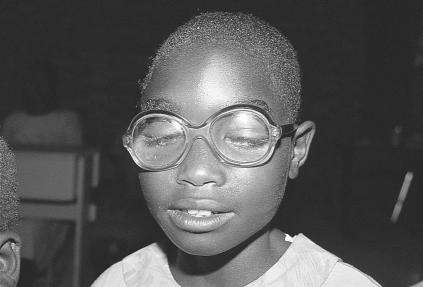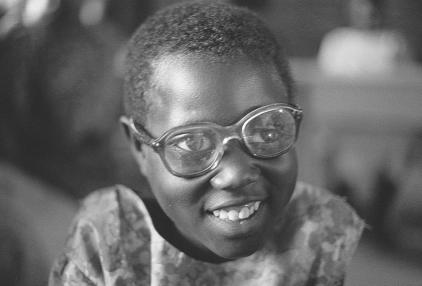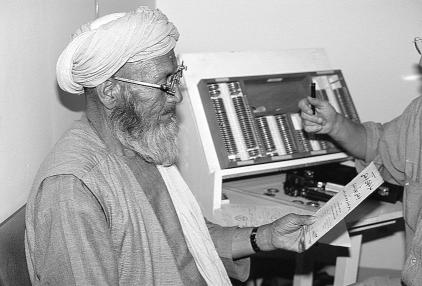Many people coming to eye clinics have refractive errors and can have their vision improved by spectacles (glasses). Most of these can be tested by general eye health workers without special training and using only a trial set of lenses. It is also useful to find out quickly which people do not have refractive errors and do not need glasses. Most errors can be corrected satisfactorily with spherical lenses that can be obtained cheaply. Not many have important astigmatic errors needing cylindrical lenses. The simplest method is to have a range of spectacles and let the person try them on, but this can be misleading. This article describes methods that are both simple and accurate.
Visual Acuity
Testing of visual acuity is very important. The best possible correction (spectacles) depends on the person'saccurate answers. Each eye should be examined separately to make sure that the test card has been read as far down as possible, and the person examined has not just stopped when the letters are small. If there is uncertainty about whether the person is trying, put up the trial frame with ‘plano’ lenses (+1.00D and −1.00D together = zero). Often the patient will think that these are spectacles and will try harder. If the acuity is below normal, always use a pinhole. This acts by letting through a narrow beam of light and so reduces the blur on the retina if there is a refractive error. A pinhole acts as a universal lens, so improvement usually means a refractive error, provided the error is moderate. Remember to have good lighting on the letters as the pinhole is tiny. (Prove the effectiveness of the pinhole by blurring your own sight with a plus lens and seeing the improvement with a pinhole).
Refractive States of the Eye
The refractive state of the eye is measured looking in the distance (usually 6 metres) so that the ciliary muscle is relaxed (that is not accommodated). There are 3 possible refractive states:
Emmetropia. The rays from a distant object are focused on the retina, so there is no refractive error and the acuity is normal.
Myopia. The rays are focused in front of the retina and so they are blurred when they reach the retina, and the acuity is decreased.
Hyperopia (also called hypermetropia). The rays are aiming towards a focus behind the retina and so they are blurred at the retina. The visual acuity is decreased except for young people who can use their accommodation to focus on the retina (people who are not hyperopic only use accommodation for near vision).
Astigmatism differs in that rays in different planes are focused at different levels. This refractive state needs cylindrical lenses to correct and so is not described here.
Presbyopia is not a refractive error in the sense used here – it is a failure to change refraction so as to look at a near object. This happens to all of us with advancing age whatever our basic refractive state.
Note that refractive errors always cause decreased acuity (except for hyperopia in young people) so the main complaint is blurred vision, usually for a long time. Eye strain is usually not a major symptom except in young people with hyperopia who are having to use accommodation all the time. Most people with good visual acuity will still show small refractive errors. However, if 6/6 or 6/9 is achieved glasses are not really needed.
Correcting Refractive Errors
To find out what lens is needed, put up lenses into the trial frame and proceed according to what is read on the Snellen chart until the best acuity is reached. As a guide, one dioptre of error (either plus or minus) reduces the acuity to about 6/18 in the emmetropic eye. In a person with two or three dioptres of error, vision will be around 6/36 or 6/60. If the acuity is only counting fingers, 5.00D or more may be needed; for example, aphakia will need about +10.00D. Try both plus and minus lenses of appropriate strengths (to avoid confusion call them ‘number 1’ and ‘number 2’). The person should at once say which is preferred. If minus is preferred the person is myopic, if plus, the person is hyperopic. Proceed with plus or minus lenses according to choice, increasing or decreasing the strength of the lens until best acuity is achieved (if possible 6/6 or better).
Spectacle correction in Uganda
Photo: Murray McGavin
This should be straightforward, but an exception is hyperopia because young hyperopic people can get good acuity without spectacles by using their accommodation. The clue to this is that when plus lenses are added blurring does not occur because accommodation is simply reduced. Continue to increase the plus until blurring occurs; the last clear lens is the correct one. Older hyperopic people will of course not have clear vision until they have been at least partially corrected, because they are losing their accommodation.
The reasons for this important rule are these:
If a myopic person is given too much minus, this will be counteracted by using accommodation which rapidly becomes very uncomfortable. (Try wearing minus lenses yourself for a few minutes – you may see clearly, but you will soon have a headache!).
In contrast, hyperopic people need to have maximum plus to relax the accommodation. These persons are accustomed to using accommodation for distant viewing and do not get a headache from it. (If you do not understand this explanation, do not worry, just remember the rule – min-minus-max-plus. This means that before you write the final prescription, reduce the minus or increase the plus by 0.25D or 0.50D and confirm that the acuity does decrease slightly).
Remember this golden rule: Give the minimum minus or the maximum plus which produces best vision
A visual acuity of 6/6 (or near to it) satisfies most people. If this cannot be achieved, examine the eye again in case there is another cause for decreased acuity such as early lens opacity. The other possible reason is that there may be significant astigmatism. A clue to this is provided by adding a pinhole to the best lens and this should produce an improvement. If so, refer the person to someone who can carry out astigmatic refraction.
This visually impaired child is clearly delighted as spectacles have improved her vision.
Photo: Murray McGavin
Refracting People with Normal Visual Acuity
People often come to the clinic thinking they need glasses even when their acuity is normal and they have no refractive error. This especially applies to students who are suffering eye strain from the stress of study. They need refraction – and careful explanation of the results. If they have normal acuity, significant myopia or astigmatism can immediately be excluded, because these would decrease acuity unless the refractive error is minimal. This leaves two possibilities: either they are normal (emmetropic), or they are hyperopic but using accommodation even for distance. It is easy to distinguish these two. If an emmetropic person looks through a weak plus lens, the vision is blurred a little. But hyperopic people just reduce by the same amount the accommodation they were using, and can still see clearly.
In practice, have the person look at the smallest line they can read (usually 6/6 or 6/5) then put up +0.75D or +1.00D. If the vision is blurred they are emmetropic. If the vision is not blurred, they are hyperopic, so continue increasing plus until the maximum is reached which still gives clear vision. If a young person has mild hyperopia (say less than +1.50 D) it is doubtful if he or she will really be helped by glasses, since they see well and comfortably using a little accommodation. Higher amounts should be corrected with glasses.
Presbyopia
To change focus from looking in the distance to looking at a near object, the eye must increase its plus by changing the thickness of its own lens. A child can do this easily and focus on a very near object. But with increasing age the lens gets hard and cannot change shape so easily. Around 40 years of age this becomes noticeable and a book cannot be held near enough to be read easily. An illiterate person will have difficulty picking stones from rice or sewing. Note this happens to everyone, but if a person is myopic it does not matter as they are already focused close up, and simply take off their glasses to read a book. Hyperopic people on the other hand will notice it earlier as they are already using some of their accommodation just to look in the distance, and have to use more to read a book. Remember that presbyopia is a problem for people of middle age or older. Young students often greatly desire reading glasses, but unless they have a real refractive error, it is not good sense to give them – they will just find them a nuisance.
Presbyopia needs correcting with added plus lenses. At the onset these persons will need about +1.00D added, increasing as they get older. In old age they will need +3.00D added, as their accommodation will then be near zero. Plus 3.00D changes the focus from distance to 33cm, which is convenient for reading a book, so this is the maximum add that is usually needed. Think of it as plus added, because it is added to the correction for distance. Therefore, a person who is +4.00D hyperopic and who needs +2.00D add will use +6.00D for reading (+4.00D +2.00D = +6.00D). A person who is −3.00D myopic and who needs +3.00D add will read a book with no glasses (−3.00D +3.00D = zero). An emmetropic person just uses whatever plus is required.
The easiest way to correct presbyopia is to let the person choose from a selection of glasses of different strengths. This works but can result in glasses that are too strong or too weak and are uncomfortable. Here is a simple but more accurate way:
Measure the nearest point of clear vision with the glasses that you think are correct. Do this by holding the book too close so it is blurred, and then slowly moving it away until the person reports it is totally clear.
Measure the distance of this nearest clear point from the eye with a tape measure or piece of string.
Change the strength of the lenses until the nearest point is about 28–30cm from eye to book, and the person is reading comfortably.
Remind the person that in another 3 to 5 years, as they get older, they will need new stronger glasses until they reach the full +3.00D add.
Advise the person that the glasses are for near and should not be used when walking around. Note that anyone who has had cataract surgery (even a child) will need the full +3.00D add for reading (in addition to their distance correction) as they have no accommodation at all.
Step by Step Summary
Refractive errors:
Take the distance visual acuity of each eye carefully
If it is below normal, repeat the acuity with a pinhole
Examine the eyes for other problems that could reduce the acuity
If a refractive error is suspected, estimate its strength
Try plus and minus lenses of that strength
Ask the person to say which one makes an improvement
Continue increasing or decreasing that one until you get best vision
Check that minimum minus or maximum plus achieving best vision has been given
If acuity is still not good, add a pinhole to the best lens
If the pinhole gives an improvement and astigmatism is suspected – refer
People with normal visual acuity:
Make the person look at the 6/6 or 6/5 line
Put a +0.75 D lens in front of each eye in turn
If there is blurring, the person is emmetropic
If there is no blurring the person is hyperopic, so continue adding plus as usual
Presbyopia:
First find the distance correction of a refractive error, if there is any
Estimate the plus add needed according to the person'sage
Put this correction in the trial frame and measure the nearest point of clear vision with a book
Change the lenses if necessary till the nearest point is 28 to 30 cm
Give reading glasses of that strength
‘Correcting’ presbyopia in central Asia
Photo: Murray McGavin





